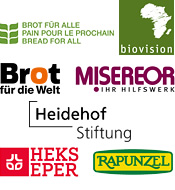News
15.02.2024 | permalink
Global organic farmland up 26% in 2022, reaching 96 million hectares

The global organic farming area increased by over 20 million hectares or 26.6 % between 2021 and 2022 and grew more than ever before. Around 96 million hectares of land were farmed organically in 2022, according to a new report published by FiBL and IFOAM – Organics International. The number of organic farmers also rose significantly, surpassing 4.5 million, and the sales of organic food reached nearly 135 billion euros in 2022. The 25th edition of the statistical yearbook “The World of Organic Agriculture” was presented on February 13th at BIOFACH, the world's leading trade fair for organic food in Nuremberg. It offers a comprehensive review of recent developments in global organic agriculture and includes detailed statistics on organic farming activities in 188 countries. According to the publishers, it also highlights the role of organic agriculture in overarching sustainability strategies such as the Sustainable Development Goals and the European Union's Farm to Fork Strategy: “Considering that organic agriculture significantly contributes to all of these goals and strategies, this book not only presents data on land area, the number of producers, and market figures but also shows organic agriculture's relevance in addressing climate change, ensuring food and nutrition security, halting biodiversity loss, and promoting sustainable consumption,” Dr. Jürn Sanders, Chairman of the Management Board of FiBL Switzerland and IFOAM President Karen Mapusua write in the foreword to the report. “Thus, it underscores its contribution to the transformation of food systems as a whole (…) and to a sustainable future.”
Australia remains the country with the largest area of organic agriculture at 53 million hectares but it is estimated that 97 % of the farmland is extensive grazing areas. Australia’s organic farming area saw a tremendous increase of 17.3 million hectares. India ranks second with 4.7 million and Argentina third with 4 million hectares, followed by China with 2.9 million hectares. France is in fifth place (2.88m hectares). Due to the large area of organic farmland in Australia, more than half of the global organic area lies in Oceania (55.2 %). Europe had the second largest area (18.4 million hectares or 19.1 %), followed by Latin America (9.5 million hectares or 9.9 %), Asia (8.8m hectares or 9.2 %), and Africa (2.7m hectares or 2.8 %). Currently, only 2 % of the world’s agricultural land is farmed organically, but many countries have far higher shares. In 22 countries, 10% or more of all agricultural land was under organic management in 2022, up from 20 countries in 2021. The top five countries with the largest share of organic land were Liechtenstein (43 %), Austria (27.5 %) and Estonia (23.4 %). Many island states have high shares of agricultural land under organic management, such as São Tomé and Príncipe (21.2 %) and Dominica (11.6 %). In the European Union, the organic share of the total agricultural land was 10.4 % while in the other regions, the share is less than 1 %. According to the report, there were 4.5 million organic farmers worldwide in 2022 and their number increased by 26 % compared to the year before, primarily thanks to a significant increase in India. However, the authors point out that calculating precise figures is difficult here because some countries only report the number of companies, projects or growers’ groups which may each comprise many individual producers, hence the total number might even be higher. The largest share of the world’s organic producers (60.6%) lives in Asia, while Africa is home to 21.6 % and Europe to 10.6 % of organic farmers. The country with the highest absolute numbers is India with 2.5 million farmers, followed by Uganda (404,246), as well as Thailand and Ethiopia with 121.500 producers respectively.
The global market for organic food and consumer demand across the globe continued to grow. Global retail sales of organic food and drink reached around 135 billion euros in 2022 and experienced a total increase of 4 billion euros (+3 %) from the previous year. In 2022, the United States continued to be the leading market with 56.6 billion euros, followed by Germany (15.3bn euros), China (12.4bn euros) and France (12.1bn euros). While several countries in Europe experienced a decline, retail sales in Canada rose by 9.7 %, followed by Japan where sales were up 8.4 %. When the shares the organic market has of the total market are considered, the leader remained Denmark with 12%, followed by Austria (11.5 %) and Switzerland (11.2 %). Swiss consumers spent the most on organic food with an average of 437 euros per person, followed by Denmark where the average consumer spent 365 euros, followed by Austria and Luxembourg with 274 euros and 259 euros respectively. In a special chapter on the global market for organic food and drink, Amarjit Sahota of Ecovia Intelligence puts the bare figures in perspective: “The organic products market has been adversely affected by global geopolitical conflicts and uncertain economic conditions. Revenue growth continued in 2022; however, this has been partly because of rising organic food prices,” he writes in the report. “Some countries, including Germany and France, reported declines in monetary sales and volumes. In the USA and other countries, revenue growth has been at a comparatively low rate.” He says that the organic food industry is not immune to geopolitical conflict that is causing disruption in global supply chains of agricultural products. However, he expects healthy growth to resume as economic conditions improve. (ab)

